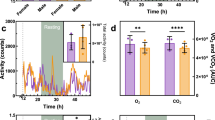Abstract
Acute Intermittent porphyria (AIP) is a human disease resulting from a dominantly inherited partial deficiency of the heme biosynthetic enzyme, porphobilinogen deaminase (PBGD)1–3. The frequency of the trait for AIP is 1/10,000 in most populations, but may be markedly higher (1/500) in psychiatric patients1,4. The clinical expression of the disease is characterized by acute, life-threatening attacks of ‘porphyric neuropathy’ that include abdominal pain, motor and sensory neurological deficits and psychiatric symptoms1. Attacks are frequently precipitated by drugs, alcohol and low caloric intake. Identical symptoms occur in other hepatic porphyrias. To study the pathogenesis of the neurologic symptoms of AIP we have generated Pbgd-deficient mice by gene targeting. These mice exhibit the typical biochemical characteristics of human AIP, notably, decreased hepatic Pbgd activity, increased δ-aminolevulinic acid synthase activity and massively increased urinary excretion of the heme precursor, δ-aminolevulinic acid after treatment with drugs such as phenobarbital. Behavioural tests reveal decreased motor function and-histo-pathological findings include axonal neuropathy and neurologic muscle atrophy.
This is a preview of subscription content, access via your institution
Access options
Subscribe to this journal
Receive 12 print issues and online access
$209.00 per year
only $17.42 per issue
Buy this article
- Purchase on Springer Link
- Instant access to full article PDF
Prices may be subject to local taxes which are calculated during checkout
Similar content being viewed by others
References
Kappas, A., Sassa, S., Galbraith, R.A. & Nordmann, Y. The porphyrias. In The Metabolic Basis of Inherited Disease (eds Scriver, C. et al) 1305–1365 (New York, McGraw-Hill, 1989).
Elder, G.H. Molecular genetics of disorders of haem biosynthesis. J. Clin. Pathol. 46, 977–981 (1993).
Bonkovsky, H.L. Advances in understanding and treating ‘the little imitator’, acute porphyria. Gastroenterology. 105, 590–594 (1993).
Tishler, P.V. et al. High prevalence of acute intermittent porphyria in a psychiatric patient population. Am. J. Psychiat. 142, 1430–1436 (1985).
Ledermann, B. & Bürki, K. Establishment of a germ-line competent 0576176 embryonic stem cell line. Exp. Cell Res. 197, 254–258 (1991).
Grandchamp, B. et al. Tissue-specific expression of porphobilinogen deaminase. Two isoenzymes from a single gene. Eur. J. Biochem. 162, 105–110 (1987).
Beaumont, C., Porcher, C., Picat, C., Nordmann, Y. & Grandchamp, B. The mouse porphobilinogen deaminase gene. Structural organization, sequence and transcriptional analysis. J. Biol. Chem. 264, 14829–14834 (1989).
Johnson, P. & Friedmann, T. Limited bidirectional activity of two housekeeping gene promoters: human HPRT and PGK. Gene 88, 207–213 (1990).
Eales, L. & Dowdle, E.B. The acute porphyric attack I. The electrolyte disorder of the acute porphyric attack and the possible role of delta-aminolevulinic acid. S. Afr. J. Lab. Clin. Med. 17, 89–97 (1971).
Andersson, C. & Lithner, F. Hypertension and renal disease in patients with acute intermittent porphyria. J. Int. Med. 236, 169–175 (1994).
Cavanagh, J.B. & Mellick, R.S. On the nature of the peripheral nerve lesions associated with acute intermittent porphyria. J. Neurol. Neurosurg. Psychiat. 28, 320–327 (1965).
Hruska, R.E., Kennedy, S. & Silbergeld, E.K. Quantitative aspects of normal locomotion in rats. Life Sci. 25, 171–180 (1979).
Medinaceli, L., Freed, W.J. & Wyatt, R.J. An index of the functional condition of rat sciatic nerve based on measurements made from walking tracks. Expl. Neurol. 77, 634–643 (1982).
Albers, J.W., Robertson, W.C. & Daube, J.R. Electrodiagnostic findings in acute porphyric neuropathy. Muscle Nerve. 1, 292–296 (1978).
Bonkowsky, H.L. & Schady, W., Manifestations of Acute Porphyria in Seminar Liver Dis. 2, 108–124 (1982).
Müller, W.E. & Snyder, S.H. δ-Aminolevulinic acid: influences on synaptic GABA receptor binding may explain CNS symptoms of porphyria. Ann. Neurol. 2, 340–342 (1977).
Brennan, M.J.W. & Cantrill, R.C. δ-Aminolaevulinic acid is a potent agonist for GABA autoreceptor. Nature 280, 514–515 (1979).
Litman, D.A. & Correia, M.A. L-Tryptophan: a common denominator of biochemical and neurological events of acute hepatic porphyria. Science 222, 1031–1033 (1983).
Nordmann, Y., de Verneuil, H., Deybach, J.-C., Delfau, M.-H., & Grandchamp, B. Molecular genetics of porphyrias. Ann. Med. 22, 387–391 (1990).
Louie, G.V. et al. Structure of porphobilinogen deaminase reveals a flexible multidomain polymerase with a single catalytic site. Nature 359, 33–39 (1992).
Brownlie, P.D. et al. The three-dimensional structures of mutants of porphobilinogen deaminase: Toward an understanding of the structural basis of acute intermittent porphyria. Protein Sci. 3, 1644–1650 (1994).
Chen, C.-H., Astrin, K.H., Lee, G., Anderson, K.E. & Desnick, R.J. Acute intermittent porphyria: identification and expression of exonic mutations in the hydroxymethylbilane synthase gene. J. Clin. Invest. 94, 1927–1937 (1994).
Meyer, U.A., Strand, L.J., Doss, M., Rees, A.C. & Marver, H.S. Intermittent acute porphyria: demostration of a genetic defect in porphobilinogen metabolism. N. Engl. J. Med. 286, 1277–1282 (1972).
Poland, A. & Glover, E. 2,3,7,8-Tetrachlorodibenzo-p-dioxin: a potent inducer of aminolevulinic acid synthetase.Science 179, 476–477 (1972).
Tomokuni, K., Ichiba, M., Hirai, Y. & Hasegawa, T. Optimized liquid-chromatographic method for fluorometric determination of urinary 8-aminolevulinic acid in workers exposed to lead. Clin. Chem. 33, 1665–1667 (1987).
Bielchowsky, M., Silber-lmprägnation der Neurofibrillen. J. Psychol. Neurol. 3, 169–188 (1904).
Author information
Authors and Affiliations
Rights and permissions
About this article
Cite this article
Lindberg, R., Porcher, C., Grandchamp, B. et al. Porphobilinogen deaminase deficiency in mice causes a neuropathy resembling that of human hepatic porphyria. Nat Genet 12, 195–199 (1996). https://doi.org/10.1038/ng0296-195
Received:
Accepted:
Issue Date:
DOI: https://doi.org/10.1038/ng0296-195
This article is cited by
-
An expanded set of genome-wide association studies of brain imaging phenotypes in UK Biobank
Nature Neuroscience (2021)
-
Severe hydroxymethylbilane synthase deficiency causes depression-like behavior and mitochondrial dysfunction in a mouse model of homozygous dominant acute intermittent porphyria
Acta Neuropathologica Communications (2020)
-
Systemic messenger RNA as an etiological treatment for acute intermittent porphyria
Nature Medicine (2018)
-
Preclinical Development of a Subcutaneous ALAS1 RNAi Therapeutic for Treatment of Hepatic Porphyrias Using Circulating RNA Quantification
Molecular Therapy - Nucleic Acids (2015)
-
High prevalence of and potential mechanisms for chronic kidney disease in patients with acute intermittent porphyria
Kidney International (2015)



